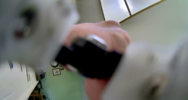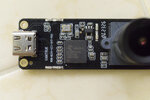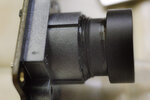DigitalCorpus
Active Member
- Joined
- Oct 17, 2023
- Messages
- 112
- Reaction score
- 71
- Location
- California
- Country
- United States
- Dash Cam
- Vantrue N4 Pro
It is mechanical. It is based off of the expected M12 lenses. As is reasonable, Vantrue (or the ODM) secured it properly considering the "extreme" thermal cycling, the harsh vibration environment of cars, and I will not fault them here. Unfortunately, they way they applied the adhesive is as a thread lock. And it works ***really*** well as such since it feels similar to a hardened version of hot glue.
TL;DR
The focus problems are a because of a poor QA/QC processes in place. If the lens is screwed in too much, then you could shim the mount with *thin* paper and fix the problem. Too little, you have to replace the mount and the lens.
I have nylon jaw pliers. Though they can lack grip, I consider this a non-diy-able focus adjustment as I was applying a lot of torque. Here is the most dramatic frame grab:

And while I was there, PCB shots:


Edit: The SOIC-8/SOP-8 is a 4MiB flash memory IC where the firmware and config for image processing are stored. A couple of transistors, standard assortment of caps, resistors, and a few inductors and transistors. Then the SoC.
The lens housing is machined metal. The mount is glass fiber reinforced polymer, probably nylon. Instead of a could of dabs of adhesive to affix the lens in a static location, the vibration heavy and thermal cycling of an automotive environment means they wanted to fix the lens in place. This means they used the adhesive as a thread lock. It can be cut with a razor and some effort. Based on that amount of force experienced, removing this lens [from the mount] will mean something gets broken.

I'm going to check the dimensions of the mount and its alignment pins to see if an eBay part will be able to be dropped in. If so, then the focus problems can be resolved assuming it is a front focus problem. If it is a back focus problem, then you could remove the mount + lens and put some very thin paper between it and the PCB.
Now, given how secure the lens is mounted, your last ditch resort, which I *highly* advise to not do, is to use some files and remove material between the lens mount and the PCB. If you don't know what a micrometer is and calipers are the finest measuring tool you have, this isn't for you. We're in the lapping realm of material removal.
TL;DR
The focus problems are a because of a poor QA/QC processes in place. If the lens is screwed in too much, then you could shim the mount with *thin* paper and fix the problem. Too little, you have to replace the mount and the lens.
I have nylon jaw pliers. Though they can lack grip, I consider this a non-diy-able focus adjustment as I was applying a lot of torque. Here is the most dramatic frame grab:

And while I was there, PCB shots:


Edit: The SOIC-8/SOP-8 is a 4MiB flash memory IC where the firmware and config for image processing are stored. A couple of transistors, standard assortment of caps, resistors, and a few inductors and transistors. Then the SoC.
The lens housing is machined metal. The mount is glass fiber reinforced polymer, probably nylon. Instead of a could of dabs of adhesive to affix the lens in a static location, the vibration heavy and thermal cycling of an automotive environment means they wanted to fix the lens in place. This means they used the adhesive as a thread lock. It can be cut with a razor and some effort. Based on that amount of force experienced, removing this lens [from the mount] will mean something gets broken.

I'm going to check the dimensions of the mount and its alignment pins to see if an eBay part will be able to be dropped in. If so, then the focus problems can be resolved assuming it is a front focus problem. If it is a back focus problem, then you could remove the mount + lens and put some very thin paper between it and the PCB.
Now, given how secure the lens is mounted, your last ditch resort, which I *highly* advise to not do, is to use some files and remove material between the lens mount and the PCB. If you don't know what a micrometer is and calipers are the finest measuring tool you have, this isn't for you. We're in the lapping realm of material removal.
Last edited:
